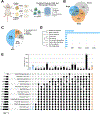Profiling mouse brown and white adipocytes to identify metabolically relevant small ORFs and functional microproteins
- PMID: 36599300
- PMCID: PMC9889109
- DOI: 10.1016/j.cmet.2022.12.004
Profiling mouse brown and white adipocytes to identify metabolically relevant small ORFs and functional microproteins
Abstract
Microproteins (MPs) are a potentially rich source of uncharacterized metabolic regulators. Here, we use ribosome profiling (Ribo-seq) to curate 3,877 unannotated MP-encoding small ORFs (smORFs) in primary brown, white, and beige mouse adipocytes. Of these, we validated 85 MPs by proteomics, including 33 circulating MPs in mouse plasma. Analyses of MP-encoding mRNAs under different physiological conditions (high-fat diet) revealed that numerous MPs are regulated in adipose tissue in vivo and are co-expressed with established metabolic genes. Furthermore, Ribo-seq provided evidence for the translation of Gm8773, which encodes a secreted MP that is homologous to human and chicken FAM237B. Gm8773 is highly expressed in the arcuate nucleus of the hypothalamus, and intracerebroventricular administration of recombinant mFAM237B showed orexigenic activity in obese mice. Together, these data highlight the value of this adipocyte MP database in identifying MPs with roles in fundamental metabolic and physiological processes such as feeding.
Keywords: Ribo-seq; brown adipose tissue; data-independent acquisition mass spectrometry; diet-induced obesity; microproteins; ribosome profiling; secreted microproteins; small ORFs; white adipose tissue.
Copyright © 2022 The Author(s). Published by Elsevier Inc. All rights reserved.
Conflict of interest statement
Declaration of interests All authors affiliated with the Novo Nordisk Research Center Seattle, Inc. have worked for a for-profit commercial pharmaceuticals company that produces and sells medicines for the treatment of obesity and diabetes. B.C.S. is a founder and shareholder of Proteome Software. M.J.M. has a sponsored research agreement with and is a paid consultant for Thermo Fisher Scientific. A. Saghatelian is a paid consultant and shareholder for and cofounder of Exo Therapeutics and Velia Therapeutics. T.F.M. is a paid consultant and shareholder of Velia Therapeutics. C.A.B. is a current employee of Velia Therapeutics.
Figures








